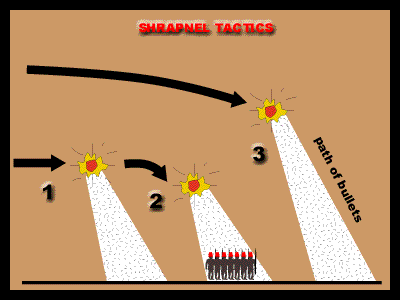

A= Preferred elevation for solid shot. Maximizes number of possible casualties.
B= As elevation is increased the killing zone is decreased.
C= This elevation would be useful only if exploding shot was used.
These graphs show the importance of setting the fuse correctly. Setting the fuse and elevation required well-trained artillery men.

1= Trajectory correct. Fuse too short.
2= Trajectory correct. Fuse correct.
3= Fuse correct. Trajectory incorrect.
It is very difficult (and meaningless) to determine the extreme range of any piece of artillery. For example, it has been found that a 24-pounder gun (9½ feet) at 45 degrees and a charge of 8 pounds could propel a shot 4,300 yards. However, the accuracy would have been extremely poor (probably less than 5%).
S. James Gooding in his book, An Introduction to British Artillery in North America, lists the "extreme effective range" for different classes of artillery.
Light Field Artillery:
1,200-1,400 yards 12- and 24-pounder Howitzer:
1,000 yards (plus) Heavy Artillery:
1,600-1,700 yards 8- and 13-inch Mortars:
2,000-2,900 yards 56-pounder, 8- and 10-inch Shell Guns:
4,000-5,000 yards
It is has been suggested that under the most favourable circumstances, 75 or 80 out of 100 shots from a smooth-bore gun would hit a large ship 1,500 yards away; 45 out of 100 if it were 2,000 yards away; but only 10 percent, if it were 3,000 yards away.
By comparison, an Armstrong gun of any caliber would probably never miss.
A smart, strong gun detachment can fire six shots from a 110-pounder Armstrong gun in six minutes; ordinary well-trained men three shots in the same time span.
Under good conditions one round per minute can be fired from heavy smooth-bore guns.
At this rate of firing, each gun in a coast battery might be fired five times at a ship moving past at 12 knots/hour, supposing the ship was 500 yards from the battery.
Lighter ordnance can be fired more quickly. Reasonable accuracy can be obtained from field guns fired at two rounds per minute. Infantry advancing under fire over 1,000 yards would be exposed to 16 to 20 rounds; cavalry charging over a similar distance only 10 to 14 rounds.
Not only was the construction of Fort Henry a deterrent, but the weapons of the fort presented a formidable force to any enemy that dare approach.
THE RECIPE FOR GUNPOWDER circa 1860 |
10 parts Sulphur
15 parts Charcoal
75 parts Saltpetre
![]()